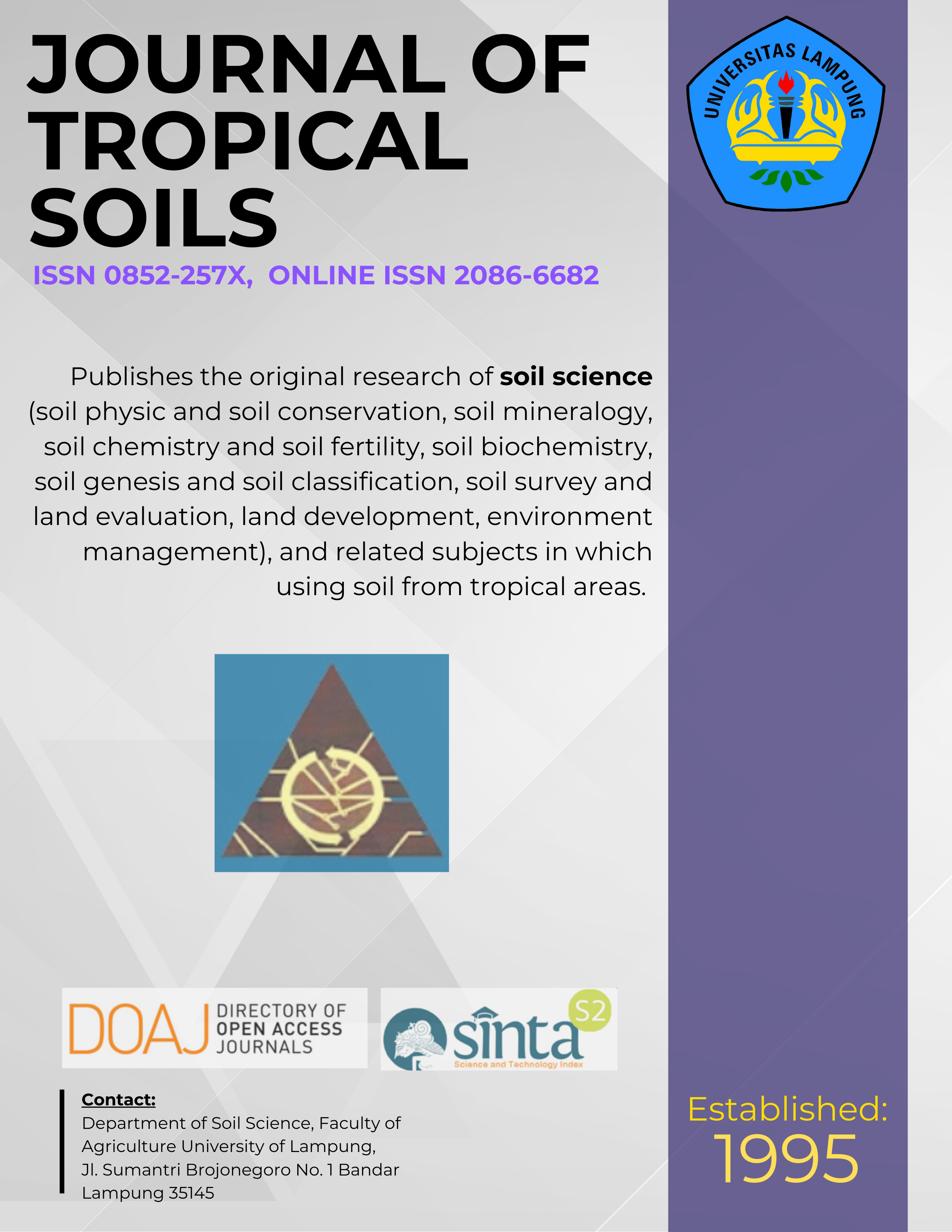Soil Development from Volcanic Ash Based on Different Pyroclastic Composition
Main Article Content
Abstract
Potential volcano in several provinces in Indonesia played a significant role in the formation and quality of soil development. Soils that developed from the volcanic ashes often thought to contribute greatly to improve soil fertility, without regard to the nature and composition of the volcanic ash produced. Volcanic ash generated from the results in volcanic activity has a different composition, there are basaltic, andesitic and granitic, thereby affecting the process of formation and characteristics of the soil. The Objective of this study is to determine the soil development from different types of pyroclastic generated from Lokon volcano in North Sulawesi. The coordinates of research was in 1o 21' 18.0" N and 124o 49' 20.2"E. this research used ARL Quant X (EDXRF Analyzer) for X-Ray Fluorescence (XRF), Shimadzu XRD-7000 for X-Ray Diffractometer (XRD), geology map (scale 1:250,000), topographic map (scale 1:50,000), XRD software, GIS 10.3 software. Soil analysis for texture, pH, C-Organic, and cation exchange capacity (CEC). There are two types of pyroclastic as the source of soil development from volcanic ash, there are; 1) basaltic pyroclastic with 43.26% Si02 that are resulted from the first magmatic eruption and 2) andesitic pyroclastic with 5.09% Si02 that are resulted from the late magmatic eruption. Basaltic pyroclastic contains Fe 37.63%, Al 11.35%, Ca 13.17% and Mg 5.69%, while andesitic pyroclastic contains Fe 38.35%, Al 6.87%, and Ca 8.61%. Rainfall ranges from 2000-3500 mm/yr helped the soil formation and influenced the character of the soil, such as sandy loam of soil texture, 3.08% of soil C-organic content, 23.24 cmol+/kg of CEC and 148.93 cmol+/kg of clay CEC. Clay minerals content of the soil is vermiculite, kaolinite and, halloysite. Cation supply from basaltic pyroclastic influenced the formation of vermiculite mineral, whereas andesitic pyroclastic more influences the formation of the kaolinite mineral. Formation of soil texture with a predominance of the sand fraction is more influenced by the type of andesitic pyroclastic that more resistant to weathering processes.
Keywords: Soil; volcanic ash; pyroclastic; vermiculite; kaolinite
Downloads
Article Details
Section
License for Authors
Authors who publish with this journal agree to the following terms:
- Authors retain copyright and grant the journal right of first publication with the work simultaneously licensed under a Creative Commons Attribution License that allows others to share the work with an acknowledgement of the work's authorship and initial publication in this journal.
- Authors are able to enter into separate, additional contractual arrangements for the non-exclusive distribution of the journal's published version of the work (e.g., post it to an institutional repository or publish it in a book), with an acknowledgement of its initial publication in this journal.
- Authors are permitted and encouraged to post their work online (e.g., in institutional repositories or on their website) prior to and during the submission process, as it can lead to productive exchanges, as well as earlier and greater citation of published work (See The Effect of Open Access).
License for Regular Users
Other regular users who want to cite, distribute, remix, tweak, and build upon author’s works, even for commercial purposes, should acknowledge the work’s authorship and initial publication in this journal, licensed under a Creative Commons Attribution License.
How to Cite
References
REFERENCES
Arnalds, O. (2013) ‘The influence of volcanic tephra (ash) on ecosystems’, in Advances in Agronomy. 1st edn. Copyright © 2013 Elsevier Inc., pp. 331–380. doi: 10.1016/B978-0-12-407685-3.00006-2.
Babiera, V. V. and Takahashi, T. (1997) ‘Characteristics of soils derived from tephra and pyroclastic flow deposits from taal volcano, the philippines’, Soil Science and Plant Nutrition, 43(4), pp. 763–776. doi: 10.1080/00380768.1997.10414643.
Borisover, M. and Davis, J. A. (2015) ‘Adsorption of Inorganic and Organic Solutes by Clay Minerals’, in Developments in Clay Science. Elsevier, pp. 33–70. doi: 10.1016/B978-0-08-100027-4.00002-4.
BPT (2005) Analisis kimia tanah, tanaman, air dan pupuk, Badan penelitian dan Pengembangan. Available at: http://balittanah.litbang.pertanian.go.id/ind/dokumentasi/juknis/juknis_kimia.pdf.
Cronin, S. J. et al. (2014) ‘Volcanic ash leachate compositions and assessment of health and agricultural hazards from 2012 hydrothermal eruptions, Tongariro, New Zealand’, Journal of Volcanology and Geothermal Research. Elsevier B.V., 286, pp. 233–247. doi: 10.1016/j.jvolgeores.2014.07.002.
Dahlgren, R. A., Saigusa, M. and Ugolini, F. C. (2004) ‘The Nature, Properties and Management of Volcanic Soils’, in Advances in Agronomy. Academic Press, pp. 113–182. doi: 10.1016/S0065-2113(03)82003-5.
Dariah, A. et al. (2015) ‘Pembenah Tanah untuk Meningkatkan Produktivitas Lahan Pertanian’, Jurnal Sumberdaya Lahan, 9(2), pp. 67–84.
Gourgaud, A., Thouret, J. C. and Bourdier, J. L. (2000) ‘Stratigraphy and textural characteristics of the 1982-83 tephra of Galunggung volcano (Indonesia): Implications for volcanic hazards’, Journal of Volcanology and Geothermal Research, 104, pp. 169–186. doi: 10.1016/S0377-0273(00)00205-5.
Hall, R. (2012) ‘Late Jurassic-Cenozoic reconstructions of the Indonesian region and the Indian Ocean’, Tectonophysics. Robert Hall, 570–571, pp. 1–41. doi: 10.1016/j.tecto.2012.04.021.
Hawkesworth, C. J. et al. (2000) ‘Time scales of crystal fractionation in magma chambers-integrating physical, isotopic and geochemical perspectives’, Journal of Petrology, 41(7), pp. 991–1006. doi: 10.1093/petrology/41.7.991.
Katili, J. A. (1975) ‘Volcanism and plate tectonics in the Indonesia Island arcs’, Tectonophysics, 26, pp. 165–188. doi: 10.1016/0040-1951(75)90088-8.
Prévosto, B. et al. (2004) ‘Effects of volcanic ash chemistry and former agricultural use on the soils and vegetation of naturally regenerated woodlands in the Massif Central, France’, Catena, 56, pp. 239–261. doi: 10.1016/j.catena.2003.10.014.
Rahayu, R. et al. (2014) ‘Dampak Erupsi Gunung Merapi Terhadap Lahan Dan Upaya-Upaya Pemulihannya’, Caraka Tani - Jurnal Ilmu Ilmu Pertanian, 29(1), pp. 61–72. doi: 10.20961/carakatani.v29i1.13320.
Siebert, L. et al. (2015) ‘Earth’s volcanoes and their eruptions: An overview’, in Sigurdsson, H. et al. (eds) Encyclopedia of Volcanoes Second Edition. 2nd edn. San Diego, pp. 239–255. doi: 10.1016/B978-0-12-3859389.00012-2.
Torrence, R. (2012) ‘Volcanic disasters and agricultural intensification: A case study from the Willaumez Peninsula, Papua New Guinea’, Quaternary International. Elsevier Ltd, 249, pp. 151–161. doi: 10.1016/j.quaint.2011.03.041.
Ugolini, F. and Zasoski, R. (1979) ‘Soils Derived from Tephra’, in Volcanic Activity and Human Ecology. Academic Press Inc, pp. 83–91.
Van Der Weijden, C. H. and Pacheco, F. A. L. (2003) ‘Hydrochemistry, weathering and weathering rates on Madeira island’, Journal of Hydrology, 283, pp. 122–145. doi: 10.1016/S0022-1694(03)00245-2.

